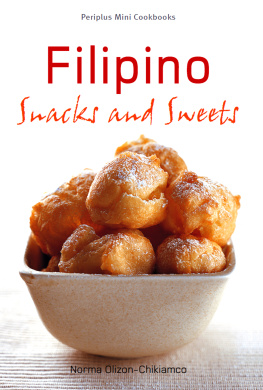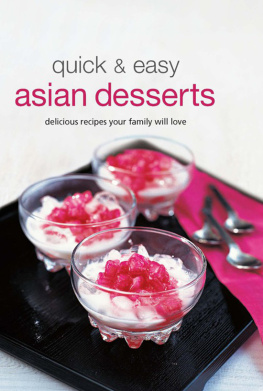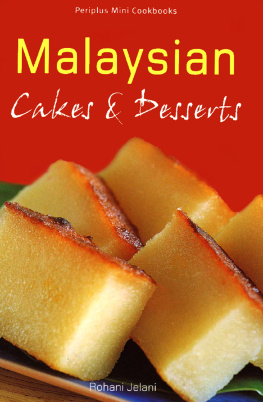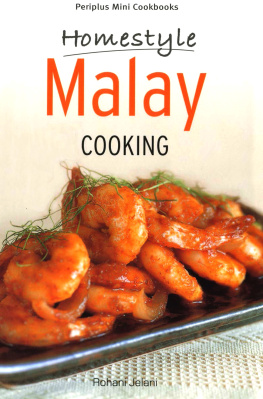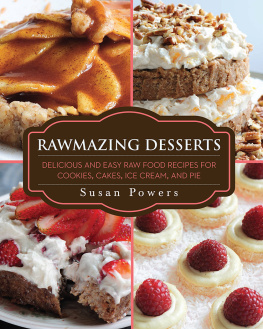Cover

Copyright

Published by Periplus Editions (HK) Ltd.
www.periplus.com
Copyright 2003 Periplus Editions (HK) Ltd. All rights reserved. The Publisher wishes to thank the following for the use of their tableware: Ugu Bigyan, Lanelle Abueva-Fernando and Rustan Supermarket Fresh. All recipes were tested in the Periplus Test Kitchen equipped by Mayer Marketing Pte Ltd.
ISBN: 9781462911035 (ebook)
Printed in Singapore 1109CP
15 14 13 12 11
8 7 6 5 4 3 2
Distributors
Asia Pacific: Berkeley Books Pte Ltd,
61 Tai Seng Avenue, #0212
Singapore 534167
Tel (65) 6280 1330; Fax (65) 6280 6290.
www.periplus.com
Indonesia: PT Java Books Indonesia,
Kawasan Industri Pulogadung
Jl. Rawa Gelam IV No. 9
Jakarta 13930, Indonesia
Tel: 62 (21) 4682 1088; Fax: 62 (21) 461 0206.
www.periplus.co.id
Photography: A. Chester Ong
Food Styling: Gina Navarro
Design: Periplus Design Team
Basic Ingredients
Basic Ingredients

Banana leaves are often used in Asian cuisine to wrap food or to line trays before cooking, much as waxed paper or aluminum foil are. This imparts a subtle fragrance to the food.

Coconut cream and coconut milk are used in many Asian desserts and curries. To obtain fresh coconut cream (which is normally used for desserts), grate the flesh of 1 coconut into a bowl (this yields about 3 cups of grated coconut flesh), add cup water and knead thoroughly a few times, then squeeze the mixture firmly in your fist or strain with a muslin cloth or cheese cloth. Thickcoconut milk is obtained by the same method but by adding double the water to the grated flesh (about 1 cup instead of cup). Thin coconut milk (which is used for curries rather than desserts) is obtained by pressing the coconut a second timeadding 1 cup of water to the same grated coconut flesh and squeezing it again. Although freshly pressed milk has more flavor, coconut cream and milk are now widely sold canned or in packets that are quick, convenient and quite tasty. Canned or packet coconut cream or milk comes in varying consistencies depending on the brand, and you will need to try them out and adjust the thickness by adding water as needed. In general, you should add 1 cup of water to 1 cup of canned or packet coconut cream to obtain thick coconut milk, or 2 cups of water to 1 cup of coconut cream to obtain thin coconut milk. These mixing ratios are only general guides however. For best results, follow the package instructions.

Pandan leaves are long thin leaves used to add delicate fragrance and a light green color to cakes and desserts. Bottled pandan essence or vanilla essence may be used as a substitute.
Shortening is a solid vegetable fat that is used to give a flaky, tender texture to baked items. It is sold in tins or packets in supermarkets and is sometimes used as a substitute for butter.
Vanilla essence, sometimes known as vanilla extract, is widely used in cakes and to flavor desserts such as custards, ice creams and beverages. It is sold in small bottles in the baking section of supermarkets.
Young toasted rice, known in the Philippines as pinipig, is toasted in a pan to make it crunchy before use in desserts or as a topping. It can also be used as a cereal or as an accompaniment to thick hot chocolate. If young toasted rice is not available, any crispy rice cereal such as Rice Krispies may be used as a substitute.
Sweet Egg and Milk Bonbons
Sweet Egg and Milk Bonbons
8 egg yolks
300 ml (1 cups) sweetened condensed milk
1 teaspoon lemon zest
300 g (1 cups) sugar
teaspoon cream of tartar
Makes about 30 bonbons
Preparation time: 5 mins
+ 1 hours for chilling.
shaping and wrapping bonbons
Cooking time: 35 mins
Combine the egg yolks and condensed milk in a double boiler. Add lemon zest. Cook over medium heat, stirring constantly, until very thick and mixture coats the back of a spoon when lifted, about 20 minutes. Chill for 1 hour for easier handling.
Grease hands and shape egg mixture into small balls, placing each ball into a greased pan.
In a saucepan, melt sugar and cream of tartar over low heat. Do not stir, otherwise sugar will crystallize. When the sugar becomes a brown syrup, stir then dip each ball into the syrup with a pair of tongs, swirling to coat evenly. Keep the syrup over low heat so it does not harden. Alternatively, if you do not wish to coat the bonbons in syrup, dust them lightly with sugar.
Put each coated ball into a greased pan and set aside to cool. Wrap individually in cellophane, if desired, before serving.
Mango Jam
Mango Jam
4 large ripe mangoes (about 2 kg/4 lbs)
250 g (1 cup) sugar
Makes 2 cups
Preparation time: 5 mins
Cooking time: 30 mins
Cut the mangoes lengthwise and scrape out the mango flesh with a spoon. Slice or mash the mango very finely then measure out 400 g (2 cups) of fruit. Reserve the mango juice.
Combine the mango flesh, sugar and reserved mango juice in a medium saucepan. Bring to the boil and simmer over medium heat, stirring constantly, until mixture thickens and has the consistency of spreadable jam.
Remove from heat. Set aside to cool, then transfer to a clean container with cover. Mango Jam may be stored in a refrigerator for up to 1 week.
Serve as a spread for bread or crackers.
Sweetened Coconut (Macapuno)
Sweetened Coconut (Macapuno)
250 g (1 cup) sugar
500 ml (2 cups) water
500 g (4 cups) grated young coconut or sport coconut flesh (see note)
1 tablespoon butter
1 teaspoon vanilla essence
Serves 6
Preparation time: 10 mins
Cooking time: 15 mins
Combine the sugar and water in a saucepan and bring to the boil. Simmer and cook until the liquid clears. Add the coconut flesh and simmer until the mixture thickens, about 5 minutes.
Stir in butter and vanilla essence. Heat through until the butter dissolves completely. Remove from the heat and set aside to cool before serving.
Sport coconuts or macapuno, are smaller and have thicker and stickier flesh and less juice than regular coconuts. Regular coconuts may be used as a substitute. They taste similar to sport coconuts but give a different texture to this dish.


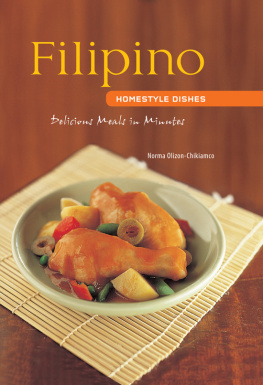
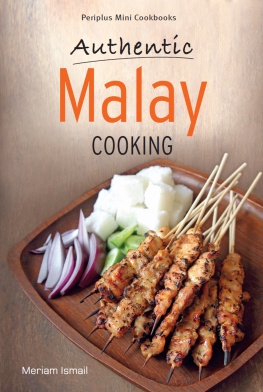
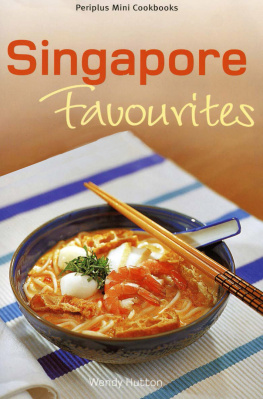
![Periplus Editors - Classic Asian cakes and desserts: [quick and delicious favorites]](/uploads/posts/book/226703/thumbs/periplus-editors-classic-asian-cakes-and.jpg)
